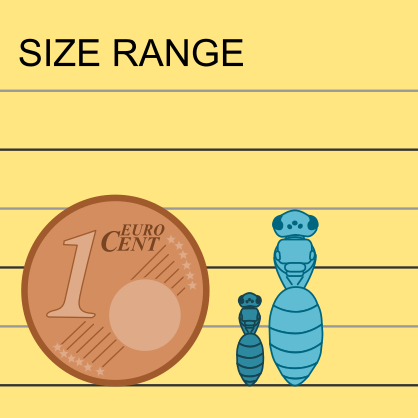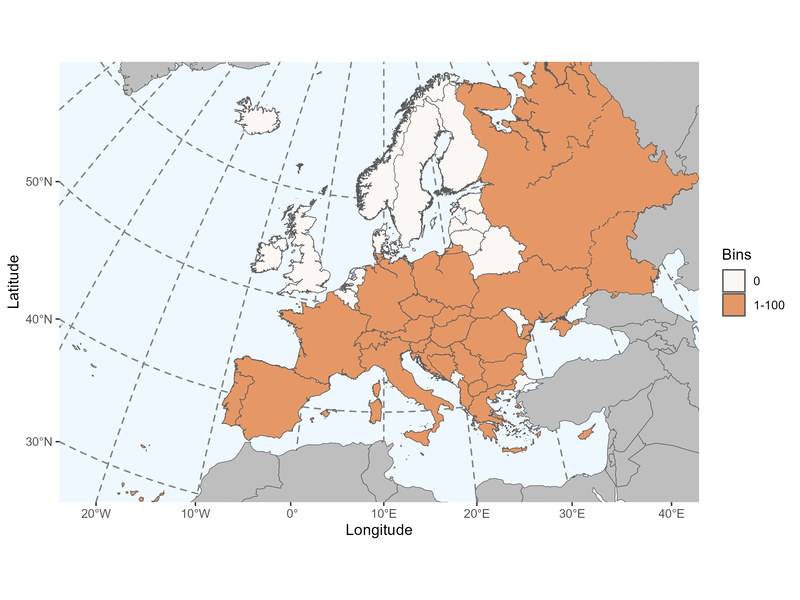Author: Friese, 1897
|
Type species: Apis quadrifasciata Villers, 1789, by designation of Cockerell, 1931.
Subgenera: Zebramegilla Brooks, 1988; Micramegilla Brooks, 1988. Synonyms: Podalirius Friese, 1897; Alfkenella Börner, 1919; Asaropoda Cockerell, 192 |
Clade: Anthophila
Family: Apidae SubF: Anthophorinae Tribe: Anthophorini |
|
Distinctive traits
|
Pictures of distinctive traits.
(Sorry, there is no picture available at this time. If you have some and would like to become a contributor to IDmyBee, please contact us.) |
Morphologically close genera and how to distinguish them:
Amegilla species stend to be smaller with well delimited hairs bands on the metasoma, and lack the arolium.
Habropoda species have a more elongated tip of marginal cell (the apex of the anterior margin of submarginal cell 3 reaches only the middle of the marginal cell), a recurrent vein reaching the apex of submarginal cell 2 and a post-furcal nervulus
- Amegilla - Anthophora
Amegilla species stend to be smaller with well delimited hairs bands on the metasoma, and lack the arolium.
- Amegilla - Habropoda
Habropoda species have a more elongated tip of marginal cell (the apex of the anterior margin of submarginal cell 3 reaches only the middle of the marginal cell), a recurrent vein reaching the apex of submarginal cell 2 and a post-furcal nervulus
General comments on Amegilla species identification
Amegilla females can be distinguished using criteria from hairs colour patterns and punctation. Male identification can be performed using facial yellow patterns, shape of posterior legs, hairs of the median legs, and may require genitalia comparisons.
Amegilla females can be distinguished using criteria from hairs colour patterns and punctation. Male identification can be performed using facial yellow patterns, shape of posterior legs, hairs of the median legs, and may require genitalia comparisons.
Sorry, but the species identification tool is not yet available for Amegilla.
Please check the reference(s) at the bottom of the page for traditional keys.
Please check the reference(s) at the bottom of the page for traditional keys.
|
List of the 11 Amegilla species found in Europe (Ghisbain et al. 2023)
Amegilla (Amegilla) canifrons (Smith, 1854) Amegilla (Amegilla) garrula (Rossi, 1790) Amegilla (Amegilla) ochroleuca (Pérez, 1879) Amegilla (Amegilla) quadrifasciata (de Villers, 1789) Amegilla (Micramegilla) andresi (Friese, 1914) Amegilla (Micramegilla) fasciata (Fabricius, 1775) Amegilla (Micramegilla) nigricornis (Morawitz, 1873) Amegilla (Micramegilla) velocissima (Fedtschenko, 1875) Amegilla (Zebramegilla) albigena (Lepeletier, 1841) Amegilla (Zebramegilla) salviae (Morawitz, 1876) Amegilla (Zebramegilla) savignyi (Lepeletier, 1841) |
|
References with identification keys for some of the species:
- Friese H. 1897. Die Bienen Europa’s (Apidae europaeae). Theil III. Solitäre Apiden. Genus Podalirius. Berlin, 316 p.
- Osychnyuk A.Z. 1978. Clef de détermination des insectes de la partie européenne d’URSS, Tome III. Hyménoptères. Première partie. Traduction partielle: Superfamille Apoidea (apoïdes). Anthophoridae. Mémoire de fin d’études, Université de Mons-Hainaut, Ecole d’Interprètes Internationaux, 100 pp.
- Scheuchl E. 1995. Illustrierte Bestimmungstabellen der Wilbienen Deutschlands und Österreichs. Band I: Anthophoridae. Ed. Erwin Scheuchl, 158 pp.
- Schwarz M. & Gusenleitner F. 2001. Beitrag sur Kenntnis paläarktischer Anthophorini und Habropodini (Hymenoptera: Apidae). Entomofauna, 22(6) : 53-92.
Page contributors:
You noticed a mistake? You have a suggestion to improve this page?
Don't keep it to yourself, contact us and become a contributor to IDmyBee!
- Adrien Perrard (Dec. 2023)
- Adrien Perrard (Dec. 2019)
You noticed a mistake? You have a suggestion to improve this page?
Don't keep it to yourself, contact us and become a contributor to IDmyBee!
References used to write this page:
- Bossert, S., E. Murray, E.A.B. Almeida, S. Brady, B. Blaimer, B.N. Danforth (2018). Combining transcriptomes and ultraconserved elements to illuminate the phylogeny of Apidae. Molecular Phylogenetics and Evolution 130 (2019): 121–131
- Ghisbain, G., Rosa, P., Bogusch, P., Flaminio, S., Le Divelec, R., Dorchin, A., Kasparek, M., Kuhlmann, M., Litman, J., Mignot, M., Müller, A., Praz, C., Radchenko, V.G., Rasmont, P., Risch, S., Roberts, S.P.M., Smit, J., Wood, T.J., Michez, D. & Reverte, S. (2023). The new annotated checklist of the wild bees of Europe (Hymenoptera: Anthophila). Zootaxa, 5327(1), 1-147.
- Michener, C.D. 2007. The Bees of the World, 2nd Edition. The John Hopkins University Press, Baltimore.
- Michez D., Rasmont P., Terzo, M., Vereecken, N. 2019. Abeilles d'Europes. Hymenoptères d'Europes, Volume 1. N.A.P. Editions.
- Nieto, A., Roberts, S. P., Kemp, J., Rasmont, P., Kuhlmann, M., García Criado, M., ... & Michez, D. 2014. European red list of bees. Luxembourg: Publication Office of the European Union, 98.
- Rasmont, P., Devalez, Jelle, Pauly, A., Michez, D. & Radchenko, V.G. 2017. Addition to the checklist of IUCN European wild bees (Hymenoptera: Apoidea). Annales de la Société entomologique de France 53: 17-32.



